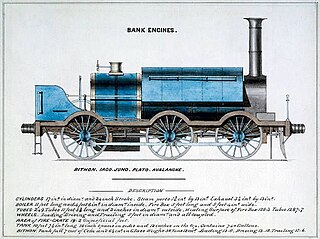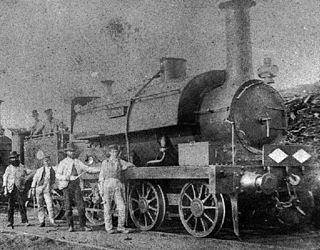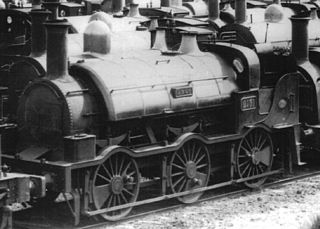
4-4-0, in the Whyte notation, denotes a steam locomotive with a wheel arrangement of four leading wheels on two axles, four powered and coupled driving wheels on two axles, and no trailing wheels.

The first Locomotives of the Great Western Railway (GWR) were specified by Isambard Kingdom Brunel but Daniel Gooch was soon appointed as the railway's Locomotive Superintendent. He designed several different 7 ft 1⁄4 in broad gauge types for the growing railway, such as the Firefly and later Iron Duke Class 2-2-2s. In 1864 Gooch was succeeded by Joseph Armstrong who brought his standard gauge experience to the workshops at Swindon. To replace some of the earlier locomotives, he put broad gauge wheels on his standard gauge locomotives and from this time on all locomotives were given numbers, including the broad gauge ones that had previously carried just names.

The Banking Class were five 0-6-0ST Brunel gauge steam locomotives for assisting ("banking") trains up inclines on the Great Western Railway. Designed by Daniel Gooch, they were tank engine versions of his Standard Goods class, and mainly built at Swindon Works.
The Great Western Railway (GWR) Bogie Class4-4-0ST were broad gauge steam locomotives for passenger train work. The first two locomotives of this class were introduced into service in August/September 1849, with the remainder following between June 1854 and March 1855. All but one were withdrawn between October 1871 and 1873, with the final locomotive being withdrawn in December 1880.
The Great Western Railway Swindon Class were broad gauge 0-6-0 locomotives built for goods train work. This class entered service between November 1865 and March 1866, and were withdrawn between June 1887 and the end of the GWR broad gauge in May 1892. The entire class was sold to the Bristol and Exeter Railway between July 1872 and September 1874 and were numbered 96-109, but returned to the GWR when that railway was absorbed. The locomotives were then renumbered 2077-2090; their names were not restored.

The Avonside Engine Company was a locomotive manufacturer in Avon Street, St. Philip's, Bristol, England between 1864 and 1934. However the business originated with an earlier enterprise Henry Stothert and Company.

South Devon Railway locomotives were broad gauge locomotives that operated over the South Devon Railway, Cornwall Railway, and West Cornwall Railway in England. They were, at times, operated by contractors on behalf of the railways.
The Comet class were 12 4-4-0ST broad gauge locomotives operated on the South Devon Railway and associated railways. They were designed for passenger trains on this steep and sharply curved line but were also used on goods trains when required.

The South Devon Railway 2-4-0 locomotives were small 2-4-0T broad gauge locomotives operated on the South Devon Railway, mainly on its branch lines such as that to Ashburton.
The four Tornado class locomotives were 0-6-0ST broad gauge locomotives operated on the South Devon Railway and associated railways. They were designed for goods trains but were also used on passenger trains when required.

The eight Dido class locomotives were 0-6-0ST broad gauge locomotives operated on the South Devon Railway and Cornwall Railway and associated other adjacent railways. They were designed for goods trains but were also used on passenger trains when required.

The Bristol and Exeter Railway locomotives worked trains on the Bristol and Exeter Railway from 1 May 1849 until the railway was amalgamated with the Great Western Railway on 1 January 1876.

The 14 Bristol and Exeter Railway 4-2-4T locomotives were broad gauge 4-2-4T steam locomotives built to three different designs. The first entered service in 1853. The Bristol and Exeter Railway was amalgamated into the Great Western Railway on 1 January 1876, and the last of the 4-2-4Ts was withdrawn in 1885.

The 26 Bristol and Exeter Railway 4-4-0ST locomotives were broad gauge 4-4-0ST steam locomotives. They first entered service in 1855 and the last was withdrawn in 1892. The Bristol and Exeter Railway was amalgamated into the Great Western Railway on 1 January 1876.

James Pearson was a 19th-century English railway engineer. He is best remembered as the designer of the distinctive Bristol and Exeter Railway 4-2-4T locomotives.
The Vale of Neath Railway (VoNR) was a broad gauge railway company, that built a line from Merthyr Tydfil and Aberdare to Neath, in Wales, mostly to transport the products of the Merthyr iron industries to ports on Swansea Bay.
Vale of Neath Railway 0-6-0ST locomotives were 0-6-0ST steam locomotives for working the heavy goods traffic on the Vale of Neath Railway and its associated lines in Wales. The first of 13 broad gauge locomotives entered service in 1854 and the last was withdrawn in 1886. The remaining four were standard gauge locomotives.
The South Wales Mineral Railway was a railway built to serve collieries in the upper Afan Valley, and bring their output to a dock at Briton Ferry, in South Wales. It opened in stages, in 1861 and 1863. It was built on the broad gauge and had steep gradients, including a rope worked incline near Briton Ferry.
During the 1880s and 1890s, William Dean constructed a series of experimental locomotives to test various new ideas in locomotive construction for the Great Western Railway.
The Daniel Gooch standard gauge locomotives comprise several classes of locomotives designed by Daniel Gooch, Superintendent of Locomotive Engines for the Great Western Railway (GWR) from 1837 to 1864.








